
Illustrated War News, 1914–1918 & 1939

“Buy "THE ILLUSTRATED WAR NEWS" and you will find every page of the greatest interest, beautifully reproduced . . . ” The Bystander, 15 November, 1939.
Newspapers provide an excellent foundation for establishing popular reactions to war [. . .] They do more than merely report events [. . .] Newspapers fuel conversation.Professor of Modern History and Memory Studies
Access the full collection
Access the full archive of Illustrated War News, 1914–1918 & 1939.
Institutional Free Trial
Start your free trialRegister for a free 30-day trial of Illustrated War News, 1914–1918 & 1939, for your institution.
Institutional Sales
Visit Sales PagesellFor more information on institutional access, visit our sales page.
Already have a license? Sign in.
Observe the transformation of modern warfare for combatants and those behind the front lines.

Released during the First World War, The Illustrated War News (IWN) was an offshoot of The Illustrated London News (ILN). Published weekly between 1914 and 1918, The Illustrated War News re-appeared briefly throughout November 1939, the opening year of the Second World War. Staunchly patriotic, its coverage related to military matters, focusing on Britain’s armed forces and on national defence. The paper portrayed all of this through a combination of full-page (and often graphic) illustrations and photographs. This collection incorporates nearly 8,600 images from 195 issues of The Illustrated War News. These were published between August 1914 and April 1918, and during November 1939. This intriguing resource, which forms part of the series British Illustrated Periodicals, 1869–1970, sheds light on the British war efforts and their portrayal in the media.
The Illustrated War News covered a wide range of topics related to warfare, from the invention of new military technologies to humanitarian aid efforts, from armament manufacturing to the experiences of prisoners of war. It reported on multiple fronts (air, land, and sea) and on pivotal theatres of war (including Africa, Europe, the Middle East, and the Pacific). The paper also published the work of many well-known war artists such as Richard Caton Woodville Jr., Henry Charles Seppings Wright, Charles Eddowes Turner, and Bryan de Grineau. The Illustrated War News illuminates key aspects of modern warfare and grants insights into how conflict was experienced by civilians and combatants. This collection contains valuable material for students and researchers interested in colonialism, military history, international history, and social and cultural history.
Contents
Illustrated War News, 1914–1918 & 1939...
“Buy "THE ILLUSTRATED WAR NEWS" and you will find every page of the greatest interest, beautifully reproduced . . . ” The Bystander, 15 November, 1939.
Discover
Highlights

Licensed to access "British and German Sailors Buried Together"
The First World War remains one of the bloodiest conflicts in human history, claiming the lives of approximately twenty million people. This photograph (image 46) depicts solidarity between combatants on both sides of the conflict: British and German servicemen are buried alongside each other following a naval battle.

Licensed to access "The West Indies' Response to the Empire's Call"
This piece (image 13) highlights the participation of soldiers from across the British Empire in the First World War (an aspect of the conflict which can be forgotten). Here, soldiers from British colonies in the Caribbean are being sworn in.

Licensed to access "Women and the War"
The First World War caused profound changes within British society. This column (image 38) reported on the various roles undertaken by women on the home front. It paid particular attention to the contributions made by women in terms of producing and maintaining vital military equipment and supplies.

Licensed to access "Prisoners of War Playing Football"
During the Second World War many thousands of soldiers on both sides of the conflict were captured and interned in Prisoner of War (POW) camps. This article (image 16) gives an insight into the everyday lives of POWs, including their leisure activities.
Insights
The Illustrated War News reveals the widespread participation of people of colour in the British and Allied forces during the World Wars — a fascinating (and often overlooked) topic which students and scholars are keen to explore. For example, this publication illustrates how, during the First World War, soldiers from Algeria fought in the French Army; how volunteers from Caribbean nations such as Jamaica, Barbados, and Guyana enlisted in the British Army; and how Māori volunteers joined the New Zealand Army. The pages of The Illustrated War News also feature extensive coverage of the British Indian Army. The paper likewise devoted attention to soldiers conscripted from African colonies and from Indochina (modern day Vietnam) by the French military.
The Illustrated War News documents the crucial role played by women throughout the First and Second World Wars. The paper’s “Women and War” column is an illuminating case in point. You can learn how women served in the armed forces, how they worked in munitions factories, how they tended to the sick and wounded in military hospitals, and how they performed vital humanitarian work in organisations such as the Red Cross. The Illustrated War News also boasts fascinating material on the Russian Women’s Battalion, the so-called “Battalion of Death”.
The Illustrated War News features extensive material on many of the most important European conflicts that occurred during the First World War, including the Battle of Verdun (1916), the Somme Offensive (1916), and the Battle of Passchendaele (1917). It also contains extensive coverage of the pivotal military campaigns that occurred in Africa and the Middle East, such as the Mesopotamian campaign (1914–1918), the East African campaign (1914–1918), and the Sinai and Palestine campaign (1915–1918).
The contributions and experiences of animals in twentieth century warfare can be overlooked. The Illustrated War News evidences how animals played significant roles on the front lines and in the rear-guard during the First World War. This collection likewise demonstrates just how important animals were to many military regiments, such as the Russian Cossack cavalry units and the British Imperial Camel Corps. The pages of The Illustrated War News also evidence how carrier pigeons relayed messages to troops, how “canine helpers” helped to locate wounded soldiers, and how horses transported munitions and bore riders into battle.
This collection provides informative (and often detailed) reports on the development of military technology. Throughout the First World War — and subsequently throughout 1939 — contributors discussed the latest innovations in the manufacture of artillery, munitions, planes, ships, and tanks.
Unlock Historical Research for Your Institution
Provide your students and researchers with direct access to unique primary sources.
Related Media


Propaganda and the Mobilisation of Consent during the two World Wars Contextual Essays

Guide to British Illustrated Periodicals, 1869–1970 Contextual Essays

Talking History: Colonial Participation in the British War Efforts | S1, Ep 6 Podcasts

Document of the Week: Image of Lord Kitchener’s Liverpool Visit, March 1915 Document of the Week

Document of the Week: Recruits of the British West Indies Regiment, 1916 Document of the Week

Document of the Week: The Elephant Munition "War-Worker" Document of the Week

















